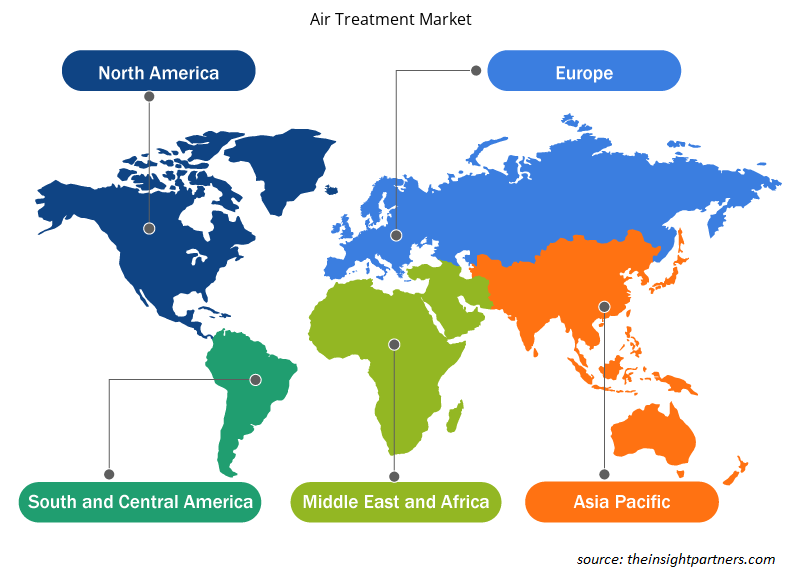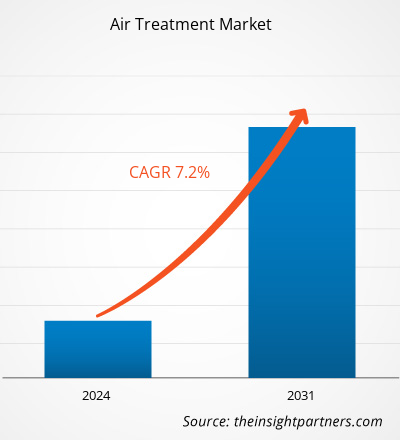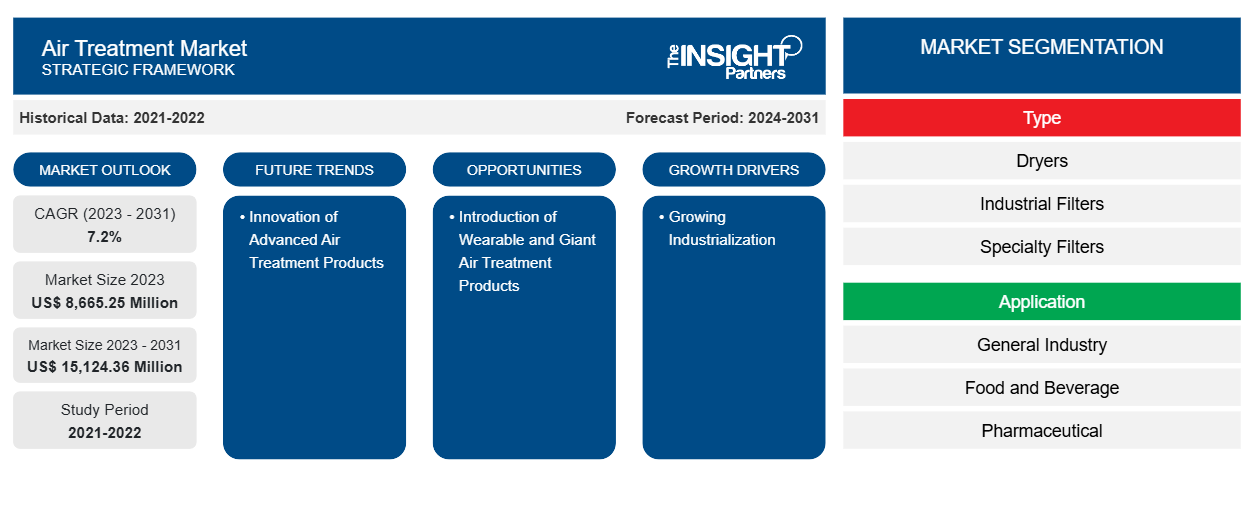Si prevede che la dimensione del mercato del trattamento dell'aria raggiungerà i 15.124,36 milioni di dollari entro il 2031, rispetto agli 8.665,25 milioni di dollari del 2023. Si prevede che il mercato registrerà un CAGR del 7,2% nel periodo 2023-2031. È probabile che l'innovazione dei prodotti avanzati per il trattamento dell'aria rimanga una tendenza chiave nel mercato.
Analisi del mercato del trattamento dell'aria
I principali utenti finali del mercato del trattamento dell'aria includono i settori dell'energia, degli alimenti e delle bevande e della petrolchimica. Si prevede che la crescita urbana avrà luogo nelle baraccopoli e in altre parti informali degli stati e dei paesi nei prossimi anni. Inoltre, le favorevoli condizioni di crescita a livello globale e i crescenti progetti infrastrutturali hanno spinto il tasso di crescita del mercato del trattamento dell'aria a livello globale.
Panoramica del mercato del trattamento dell'aria
Gli stakeholder chiave nell'ecosistema del mercato globale del trattamento dell'aria includono fornitori di hardware/componenti, produttori/fornitori di trattamento dell'aria e utenti finali. I fornitori di componenti/hardware forniscono vari componenti/parti/materie prime ai produttori di trattamento dell'aria per la produzione del prodotto finale. Per realizzare prodotti per il trattamento dell'aria vengono utilizzati diversi tipi di materie prime. Alcuni dei principali produttori di mercato nel mercato globale del trattamento dell'aria includono ABIONIK Group GmbH, Beko Technologies, Donaldson Company, Inc., Condorchem Envitech, Parker Hannifin, Kaesar Kompressoren, Mikropor, Odatech Pty Ltd., SPX FLOW, Inc. e Xebec Adsorption Inc tra molti altri.
Personalizza questo report in base alle tue esigenze
Riceverai la personalizzazione gratuita di qualsiasi report, comprese parti di questo report, o analisi a livello nazionale, pacchetto dati Excel, oltre a usufruire di grandi offerte e sconti per start-up e università
-
Scopri le principali tendenze di mercato in questo rapporto.Questo campione GRATUITO includerà analisi di dati che spaziano dalle tendenze di mercato alle stime e alle previsioni.
Driver e opportunità del mercato del trattamento dell'aria
Crescente industrializzazione per favorire il mercato
L'industria del trattamento dell'aria è guidata direttamente o indirettamente da vigorose misure governative a supporto del settore industriale, come quelle intraprese da grandi regioni come il Nord America e l'Europa, attraverso vari forum. Le politiche in Europa sono vantaggiose per lo sviluppo del business, che è una delle ragioni alla base della crescita dell'industria elettronica e delle PMI in Europa. La formazione della regione UE ha portato alla facilità di business, importazione ed esportazione tra i membri dell'Unione. Queste industrie sono molto comuni in questa regione. Pertanto, il crescente sviluppo del settore industriale sta guidando la domanda per il mercato del trattamento dell'aria a livello globale.
Introduzione di prodotti indossabili e giganti per il trattamento dell'aria
I sistemi di filtraggio dell'aria vengono installati per garantire la sicurezza nei luoghi di lavoro industriali. La tendenza crescente dei sistemi di trattamento dell'aria aiuta a catturare le particelle di fumo più piccole nelle aree industriali. La fabbricazione avanzata di metalli ha sfruttato la tecnologia avanzata e i processi di automazione per produrre prodotti che rilasciano processi di riscaldamento, gas nocivi e fumi come sottoprodotto della saldatura. Ciò ha alimentato l'installazione di sistemi di raccolta della polvere con cartucce di filtraggio di alta qualità. Il crescente avvento di prodotti di trattamento dell'aria indossabili e giganti nel settore industriale è uno dei principali fornitori di opportunità di crescita per il mercato nei prossimi anni.
Analisi della segmentazione del rapporto di mercato sul trattamento dell'aria
I segmenti chiave che hanno contribuito alla derivazione dell'analisi di mercato del trattamento dell'aria sono tipologia e applicazione.
- In base al tipo, il mercato del trattamento dell'aria è suddiviso in essiccatori, filtri industriali, filtri speciali e gestione della condensa. Il segmento dei filtri industriali ha detenuto una quota di mercato maggiore nel 2023.
- Per applicazione, il mercato è segmentato in industria generale, alimentare e delle bevande, farmaceutica, petrolio e gas, chimica e petrolchimica e mineraria. Il segmento farmaceutico ha detenuto una quota significativa del mercato nel 2023.
Analisi della quota di mercato del trattamento dell'aria per area geografica
L'ambito geografico del rapporto sul mercato del trattamento dell'aria è suddiviso principalmente in cinque regioni: Nord America, Asia Pacifico, Europa, Medio Oriente e Africa, Sud e Centro America.
Il Nord America è leader del mercato. La popolazione degli Stati Uniti ha uno standard di vita elevato e la capacità di spesa delle persone è immensa a causa dell'elevato reddito pro capite del paese. Ciò si traduce nell'uso di più strutture e aumenta il consumo di risorse nella regione. Ciò comporterà ulteriormente un crescente bisogno di aria fresca nel paese, influenzando così la crescita del mercato del trattamento dell'aria. Il Nord America è una regione tecnologicamente avanzata. I purificatori d'aria intelligenti hanno assistito a un'elevata adozione in questa regione. Queste tecnologie, quando integrate con le macchine, forniscono efficienze agli utenti finali. Più implementazioni richiedono più concorrenza nella regione insieme alla crescita dell'intero settore che porta allo sviluppo del mercato e alle innovazioni.
Approfondimenti regionali sul mercato del trattamento dell'aria
Le tendenze regionali e i fattori che influenzano il mercato del trattamento dell'aria durante il periodo di previsione sono stati ampiamente spiegati dagli analisti di Insight Partners. Questa sezione discute anche i segmenti e la geografia del mercato del trattamento dell'aria in Nord America, Europa, Asia Pacifico, Medio Oriente e Africa e Sud e Centro America.

- Ottieni i dati specifici regionali per il mercato del trattamento dell'aria
Ambito del rapporto sul mercato del trattamento dell'aria
| Attributo del report | Dettagli |
|---|---|
| Dimensioni del mercato nel 2023 | 8.665,25 milioni di dollari USA |
| Dimensioni del mercato entro il 2031 | 15.124,36 milioni di dollari USA |
| CAGR globale (2023-2031) | 7,2% |
| Dati storici | 2021-2022 |
| Periodo di previsione | 2024-2031 |
| Segmenti coperti |
Per tipo
|
| Regioni e Paesi coperti |
America del Nord
|
| Leader di mercato e profili aziendali chiave |
|
Densità degli attori del mercato: comprendere il suo impatto sulle dinamiche aziendali
Il mercato del trattamento dell'aria sta crescendo rapidamente, spinto dalla crescente domanda degli utenti finali dovuta a fattori quali l'evoluzione delle preferenze dei consumatori, i progressi tecnologici e una maggiore consapevolezza dei vantaggi del prodotto. Con l'aumento della domanda, le aziende stanno ampliando le loro offerte, innovando per soddisfare le esigenze dei consumatori e capitalizzando sulle tendenze emergenti, il che alimenta ulteriormente la crescita del mercato.
La densità degli operatori di mercato si riferisce alla distribuzione di aziende o società che operano in un particolare mercato o settore. Indica quanti concorrenti (operatori di mercato) sono presenti in un dato spazio di mercato in relazione alle sue dimensioni o al valore di mercato totale.
Le principali aziende che operano nel mercato del trattamento dell'aria sono:
- Tecnologie Beko
- Società per azioni Donaldson Company, Inc.
- Parker Hannifin
- Honeywell International Inc
- Impianto di depurazione di Hongrijia Science?Technology Co.,Ltd
- Ingersoll Rand Inc.
Disclaimer : le aziende elencate sopra non sono classificate secondo un ordine particolare.

- Ottieni una panoramica dei principali attori del mercato del trattamento dell'aria
Notizie e sviluppi recenti sul mercato del trattamento dell'aria
Il mercato del trattamento dell'aria viene valutato raccogliendo dati qualitativi e quantitativi dopo la ricerca primaria e secondaria, che include importanti pubblicazioni aziendali, dati associativi e database. Di seguito sono elencati alcuni degli sviluppi nel mercato del trattamento dell'aria:
- Ingersoll Rand Inc., fornitore globale di soluzioni industriali e di creazione di flussi mission-critical, ha concluso l'acquisizione di Friulair Srl ("Friulair") con un prezzo di acquisto anticipato interamente in contanti di circa 146 milioni di dollari USA. (Fonte: Ingersoll Rand Inc, comunicato stampa, febbraio 2024)
- Honeywell International Inc. ha lanciato il suo monitor della qualità dell'aria interna (IAQ), che avvisa i proprietari e gli operatori degli edifici di potenziali problemi per migliorare in modo proattivo la qualità dell'aria interna, riducendo così potenzialmente il rischio di trasmissione di contaminanti atmosferici. (Fonte: Honeywell International Inc., comunicato stampa, febbraio 2022)
Copertura e risultati del rapporto sul mercato del trattamento dell'aria
Il rapporto "Dimensioni e previsioni del mercato del trattamento dell'aria (2021-2031)" fornisce un'analisi dettagliata del mercato che copre le seguenti aree:
- Dimensioni e previsioni del mercato del trattamento dell'aria a livello globale, regionale e nazionale per tutti i principali segmenti di mercato coperti dall'ambito
- Tendenze del mercato del trattamento dell'aria e dinamiche di mercato come driver, vincoli e opportunità chiave
- Analisi PEST e SWOT dettagliate
- Analisi del mercato del trattamento dell'aria che copre le principali tendenze del mercato, il quadro globale e regionale, i principali attori, le normative e i recenti sviluppi del mercato
- Analisi del panorama industriale e della concorrenza che copre la concentrazione del mercato, l'analisi della mappa di calore, i principali attori e gli sviluppi recenti per il mercato del trattamento dell'aria
- Profili aziendali dettagliati
- Analisi storica (2 anni), anno base, previsione (7 anni) con CAGR
- Analisi PEST e SWOT
- Valore/volume delle dimensioni del mercato - Globale, Regionale, Nazionale
- Industria e panorama competitivo
- Set di dati Excel
Report recenti
Testimonianze
Motivo dell'acquisto
- Processo decisionale informato
- Comprensione delle dinamiche di mercato
- Analisi competitiva
- Analisi dei clienti
- Previsioni di mercato
- Mitigazione del rischio
- Pianificazione strategica
- Giustificazione degli investimenti
- Identificazione dei mercati emergenti
- Miglioramento delle strategie di marketing
- Aumento dell'efficienza operativa
- Allineamento alle tendenze normative























 Ottieni un campione gratuito per - Mercato del trattamento dell'aria
Ottieni un campione gratuito per - Mercato del trattamento dell'aria